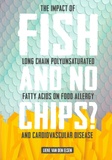The impact of long chain polyunsaturated fatty acids on food allergy and cardiovascular disease
Fish and no chips?

Elsen, Lieke van den
- Promoter:
- Prof.dr. J. (Johan) Garssen
- Co-promoter:
- Dr. L.E.M. (Linette) Willemsen
- Research group:
- Garssen
- Date:
- September 24, 2013
- Time:
- 16:15 h
Summary
This thesis creates more insight into the efficacy and mechanism of action of polyunsaturated fatty acids (PUFA), which act on the interface between pharmacology and nutrition in the prevention of allergic and cardiovascular disease. PUFA are categorized into n-6 and n-3 PUFA. The last decades have seen a fall in the consumption of long chain n-3 PUFA (LCPUFA) from oily fish, while the use of vegetable oils and products that are rich in n-6 PUFA has increased. It was demonstrated that increasing the dietary intake of soybean oil, rich in n-6 PUFA, abrogated oral tolerance induction generated by partial whey hydrolysate and enhanced allergic symptoms as assessed in a mouse model for orally induced cow’s milk allergy. Furthermore, the effects of n-6 LCPUFA arachidonic acid (AA) versus n-3 LCPUFA eicosapentaenoic acid (EPA) and docosahexaenoic acid (DHA) on mast cell degranulation, phenotype and signaling were studied in vitro. These data demonstrated that n-3 LCPUFA reduce the secretion of Th2 type mediators involved in allergy most effective. This occured via suppression of reactive oxygen species. The effect of partial substitution of dietary n-6 PUFA by n-3 LCPUFA from fish oil on the in vivo process of sensitization was studied in mice. N-3 LCPUFA largely prevented allergic sensitization to the cow’s milk protein whey in association with an increased frequency of intestinal and systemic regulatory T cells (Treg). The involvement of CD25+ Treg in whey-allergy prevention by n-3 LCPUFA was studied in detail. Adoptive transfer of splenocytes from protected donor mice confirmed that CD25+ Treg from the donor mice were involved in whey-allergy prevention in recipient mice. Furthermore, dietary EPA versus DHA were compared. For both whey and peanut allergic mice an increased efficacy of DHA over EPA in suppressing allergic symptoms was found. Besides the effect of n-3 LCPUFA from fish oil on the allergic response, the effect of these fatty acids on cardiovascular manifestations was studied. N-3 LCPUFA in spontaneously hypertensive rats reduced the blood pressure and improved endothelial function. A diet rich in DHA lowered membrane AA content, probably contributing to the reduced ceramide-mediated contractions. In addition, enhanced endothelium-dependent relaxation to metacholine and reduced production of contractile TXA2 and IL-10 were demonstrated ex vivo. Moreover, a role for n-3 LCPUFA in improving endothelial function in humans was suggested, using samples of the first dietary intervention study providing fish to pregnant women (Salmon in Pregnancy Study). We describe that fish consumption by pregnant women dampened ex vivo EC activation as demonstrated by reduced intercellular adhesion molecule 1 (ICAM-1) expression on lipopolysaccharide stimulated human umbilical vein endothelial cells. This implicates that dietary fish (oil) could suppress cardiovascular inflammation in humans. Together the results in this thesis create more insight into the efficacy and mechanism of action of n-3 LCPUFA in the prevention of food allergy and cardiovascular disease.